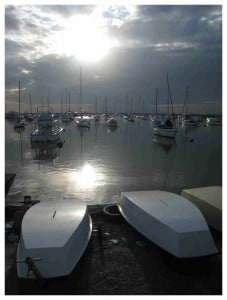iCTLT
9th – 10th April, 2014
Singapore
From its opening, the iCTLT Conference set the stage for discussions of ICTs in education by integrating the work of Singa-porean students – which ranged from creating robots to creating animations – into the conference proceedings. Key themes which emerged over a range of plenaries, spotlight sessions and concurrent papers included the need for a shift of mindset to develop educational approaches relevant to students and their future in a rapidly changing economy and society; the need to focus less on standardised tests and to encourage creativity and entrepreneurship; and, of course, the need for educators and educational leaders to become, and remain, learners, in order for this to be achieved.
In the opening plenary, Never Send a Man to Do a Machine’s Job: The Role of ICT in Educational Transformation, Yong Zhao praised many aspects of Singapore’s education and economy, but suggested that there is room for improvement in areas like entrepreneurship and societal happiness. There is a negative correlation between high PISA scores and high entrepreneurship; likewise, there is a negative correlation between high TIMMS scores and high confidence and enjoyment. Contrary to the notion that US education is declining, he claimed that US education has always been in a bad state according to past reports and studies. However, the US is still here and still doing well, and has the most prosperous economy in the world; it scores higher on confidence and happiness than countries like Singapore which do well on standardised tests.
All curriculum materials, he suggested, are bets on what characteristics and qualities will be valuable in the future; you can get your bet right or wrong. We can start with the ‘Known Knowns’ that should be taken into account: Human nature – diversity, curiosity, creativity; The economy – changed; Information – everywhere; The world – Globalised. Schools do not only help people, they exclude people. If you are good at what a school wants, you are seen as gifted and talented; otherwise you will be seen as having special needs. Schools tend to funnel individual differences, multiple intelligences, cultural diversity, curiousity and passion into a defined set of skills seen as leading to employability.
But the economy is shifting dramatically, with many employees’ positions being lost to machines. Since the 1970s there has been growth in the service sector and the creative sector. The new world is going to be dominated by the creative class and the service class. Education has always been supposed to create the middle class; the new middle class is the creative class. But our schools, working on a sausage factory metaphor of producing employable skills, are not good at fostering creativity. Creativity only became widely discussed after the 1920s, prior to which time creative people were seen as troublemakers. Schools were and are designed to stifle creativity. Children come to school with high levels of creativity, but lose that over many years of schooling. We have gone from the age of necessity to the age of abundance. We consume choice – psychological, spiritual and cultural. Our schools can no longer discriminate against people; we need to accept that everyone can be useful in their own way.
There’s an interesting paradox – there are many graduating college students, but businesses are looking for talent they can’t find. The reason is that education has prepared employees; but what is needed is entrepreneurs. We need business entrepreneurs, social entrepreneurs, policy entrepreneurs, and ‘intrapreneurs’. If you need to be managed, you will not be a good entrepreneur. Entrepreneurs are good at seeing problems as opportunities; they are confident, passionate, and creative. Creativity, entrepreneurship, and unique talent are necessities. US schools are bad sausage-makers, which means that US schools kill creativity less successfully than Singaporean or other Asian schools.
We need to think about education not as something that fixes people’s deficits, but as something that enhances their strengths and their passion. We need to emphasise:
- What: student autonomy;
- How: Product-oriented learning;
- Where: the global campus.
Schools, in brief, should present learning opportunities where students can carve out their own pathways. ICTs in classrooms are often used for repetitive work that machines can do. Teachers will not be replaced by machines; we need to redefine our roles. Every child should be supported in developing their own strengths and becoming globally connected. Teachers should not be gateways, but rather curators of learning opportunities.
In his talk, Frameworks for Educational Technology: SAMR and the EdTech Quintet, Ruben Puentedura suggested that a first key question to ask is how our practice is changing as new technologies replace older technologies in the classroom, and a second is how the heart of what we are teaching changes with the new technologies. He outlined the 4 levels of the SAMR framework, indicating that as we progress towards higher levels, increasing improvement is possible in student outcomes. There is not so such thing as a bad level of SAMR, but there are greater opportunities at higher levels. Teachers can use a SAMR ladder to reach the higher levels.
He gave a detailed example of a SAMR ladder related to the development of vocabulary, drawing on the work of Bob Marzano, who recommended the following steps in learning vocabulary: Step 1: The teacher provides a description of the new terms; 2: Students restate them in their own way; 3: Students create nonlinguistic representations of the terms; 4: Students do activities that help them add to their knowledge of the terms; 5: Students are asked to discuss the terms with one another; 6: Students are involved in games that allow them to play with the terms. This is how this process might look when related to the SAMR model:
- Substitution level: Students enter their own description of a term on a wiki (this is straight substitution).
- Augmentation level: Students use a visual dictionary/thesaurus which presents a concept map of the term (this is a functional improvement over the use of a traditional paper-based dictionary or thesaurus).
- Modification level: Students can find images and link them to the concept map from the visual dictionary/thesaurus.
- Redefinition: Students create a digital comic using the images they have collected to tell a story, which is shared with and commented on by other students (this fulfils the last 3 of Marzano’s steps – doing activities, discussing with each other, and engaging in a non-trivial ludic exercise).
Puentedura went on to relate the SAMR model to the TPACK framework, indicating that it is important for teachers to keep CK, PK and TK in balance; by starting with any one of these, you lock out some possibilities. The key areas are the overlapping areas, e.g., PCK covers how a given technology makes a given pedagogical practice possible, such as social writing on a wiki. The key area when it comes to moving up the SAMR levels, notably from Augmentation to Modification, is PCK, because it’s important to think deeply about the application of pedagogical approaches. At the centre, TPCK comes together to create maximally effective types of teaching and learning, and it is essential to moving up to Redefinition level.
Puentedura then focused on the area of literacy and, based on a number of research studies, showed a measurable increase in effect size on student outcomes as we move from Substitution to Redefinition of tasks: 0.029 – 0.264 – 0.600 – 1.563. These are fairly representative effect sizes moving across the SAMR levels. In another study involving Algebra, with a shift from Substitution to Augmentation, there was an effect size of 0.2; while in a study involving Earth Sciences, with a shift from Augmentation to Modification, there was an effect size of 0.6.
Using the Horizon Reports, Puentedura has classified new technologies into 5 categories – social, mobility, visualisation, storytelling and gaming tools. Social tools include bookmarking, discussions, blogging, telepresence, RSS feeds, microblogging, wikis and filesharing. Mobility tools include those that help overcome the classroom/homework divide, with students using devices any time and any place, accessing contextually relevant information, and sharing learning. Visualisation tools help to make abstract ideas more tangible; there are visualisations of space (maps), time (timelines), concept maps, numerical data (interactive), and textual data (such as Wordle). Digital storytelling is about bringing together multiple media to make meaning; it could refer to image assembly, sequential art, moving images, interactive media or interactive fiction. Digital gaming can help inform learning – games are rule-governed systems, with conflicts or problems to resolve, that lead to quantifiable outcomes (here, he drew on a definition by Salen & Zimmerman).
He went on to suggest that 21st century skills can be useful design principles as we create lessons that maximise learning opportunities on the SAMR model and TPACK framework.
In his talk, The Networked Leader, George Couros started with David Weinberger’s notion that ‘the smartest person in the room, is the room’; we learn a great deal through the power of connection. Nowadays, if you don’t understand what a Twitter handle or hashtag is, you are becoming illiterate, he suggested. The biggest shift for educators using technology is not a skillset, he said, it’s mindset. We constantly ask kids to think differently and grow; teachers have to be prepared to do the same. What is important is not the technology per se; it’s about relationships and learning. But students who are engaged in creating with technology outside the classroom may find themselves constrained to paper and worksheets inside the classroom. He ran through a number of myths:
- Kids are lazy. The reality, he suggested, is that they’re bored; we should be creating a culture of engagement and empowerment rather than a culture of compliance.
- Technology dehumanises. But technology can actually bring us together to accomplish amazing things.
- Kids are narcissistic. But it may be that kids are reaching out, looking for someone to listen, for someone who cares.
- New technology will replace face-to-face interaction. But people didn’t interact when they used old technologies like newspapers on trains; at least with today’s devices, people are connecting through them.
School leaders, he said, need to model – learn – humanise. We need to model for kids how to use social media platforms in positive ways. If we don’t post our own materials, we leave our online reputation up to others. By the time students leave school, it should be possible to Google them and find positive instead of problematic materials. He showed a school hashtag which is used by leaders, teachers and students on Twitter, so that good use of the medium can be modelled; a blog, where teachers and students can comment on what they’ve learned each day; and a school Instagram account, where students can record the growth of plants in the classroom over time. These are ways of helping kids begin to develop a positive digital footprint.
We also need to learn – “The world only cares about what you can do with what you know”, as Thomas Friedman pointed out. He presented numerous examples from YouTube to demonstrate that online, everyone’s a teacher, and everyone’s a learner. We can learn from our students, and they can learn from anyone in the world. Christ Anderson has spoken of “crowd accelerated innovation”, which requires radical openness. Finally, he suggested, it is important to humanise our online presence. To make meaningful change, you have to connect to people’s hearts before you connect to their minds. Leaders need to show themselves as human beings, and model that for students.
Ultimately, he concluded, the biggest games changer in education is to get an educator to think of themselves as an innovator – and to begin to make things change.
In his opening plenary on the second day, To Flip or Not to Flip, Aaron Sams indicated that getting students to prepare at home before coming to class, and then interacting in class, is a Flipped Classroom 101 model – it’s a starting point, and it sets teachers and students on the way to student-centred teaching, but we shouldn’t stop there. It’s not all that new pedagogically; there have been many other pre-teaching models, but we’re leveraging new media to do it. This allows students to do the easy work at home, and the hard work in class. Sams found that when following this model, students didn’t need all their in-class time for their work, so there was time to do more work at the higher levels of Bloom’s taxonomy. Class time became all about application, analysis, evaluation and creation. He realised that content isn’t as important as he had thought it was. Instead of having students coming to an educational institution to acquire content, we can have them come there to join a community of learning. The teacher’s role is not to deliver content, but to facilitate that community.
Video is a powerful way of delivering content, as shown by the amount of time we spend going to YouTube to learn how to do new things. It is possible to curate great content from the internet, but on the whole it is preferable for an individual teacher to create their own videos, because you have a connection, a social contract, with your students that no-one else has. You also understand their context much better. If all that mattered was content delivery, then yes, techers could be replaced by videos. However, there are other aspects of education: namely relationships and curiosity. If students watch your videos, you need to give them a reason to turn up to your class – you need to add value. It is important to balance content, relationships and curiosity.
In his second year of flipping his classroom, Sams moved to a mastery approach, based on the idea that not all students have to be engaged in the same work at the same time. But some students found the idea of needing to achieve near perfect scores on tests before moving on to be extremely frustrating. Sams then moved to a more inquiry-based learning approach. He discovered that students could learn the content this way, but it took a lot of preparation on his part. Rather than front-loading with content, he front-loaded with questions and inquiry; the content was available as a support when necessary. Now, his class was no-longer content-driven.
He then moved on to UDL – Universal Design for Learning. Students were told what they needed to learn, but they had the choice of whether to look at the textbook, the videos, or any other relevant sources. Students also needed multiple ways to demonstrate their learning; they were able to create videos, write songs, or design graphic novels to show their understanding. His next step was to move to PBL, or project-based learning. Here, students start with a project, and learn what they need as they go. With a project, you can start with creation on Bloom’s Taxonomy, with students accessing content – moving down the levels of the taxonomy – when they need to learn things along the way.
Sometimes, he suggested, teachers get too hung up on terminology. In many ways flipped learning is not all that new. He has now come up with a definition of flipped instruction. The whole model is predicated on the fact that direct instruction still has a place in learning. A lot of teachers feel locked into and controlled by content and standards – this will remain so until policymakers change their approach – but you can put that material in a video archive, and spend classroom time in other ways. All in all, it took Sams 6 years to get to his current version of flipped learning. With this kind of educational innovation, it will always be a case of two steps forward, one step back. Change of this kind is always challenging to realise.
He noted, too, that it is also possible to flip professional development, or staff meetings – don’t bring everyone to one room to tell them about decisions that are already made. Those can be communicated by email or video. Staff meeting time can then be devoted to discussion.
In the Rockmoon presentation about cutting-edge augmented reality technology in education, What Interactive Learning Trails Will You Create Next?, emphasis was placed on self-directed learning, authentic and experiential learning, and 21st century skills. Teachers are able to create their own learning trails for their students using a web-based design toolkit, Trail Shuttle, which does not involve any programming knowledge. There is also a mobile app for students, and a monitoring mobile app for teachers. Using the monitoring app, teachers can track students, view their device screens, and chat with them, and can also make last-minute alterations to trails as necessary. At the end, the system generates a report about each student which is available through the toolkit.
In his talk, New Technologies Old Behaviours: Incorporating Research and Safety in the Online World, UK Intelligence Officer Alan Earl from the Avon and Somerset Police, UK, indicated that young people are starting to leave Facebook and spreading their behaviour across multiple apps, like Instagram, Kik, WhatsApp, Snapchat, Whisper and so on. This is a constantly moving environment, where children are the early adopters. Teachers find themselves trying to teach children about online safety without understanding the tools that children are using. The issues are bigger than a term like ‘e-safety’ sounds. It’s about online lives and reputations. The message has to be balanced between positives and negatives, risk and actual harm, and filtering and dialogue. Safety has to be embedded within digital literacy.
Earl reported on an initiative called Digital Literacy & Citizenship, created in conjunction with Commonsense Media and tailored somewhat to the UK context. This has resulted amongst other things in a set of learning descriptors for different age groups, attached to resources and lesson plans. There’s a need for a holistic approach, he suggested, with online safety being taught across the curriculum. He also described 360 Safe, an e-safety self-review tool for schools, and Online Safety, a tool for assessing children and families, which can be used by social workers or educators.
All in all, the conference was a wide-ranging exploration of the current state of technology use in education, with an emphasis less on the technology itself than on big picture issues of pedagogy, education and society. This, indeed, is a perspective, or set of perspectives, towards which more ed tech conferences should be shifting.





